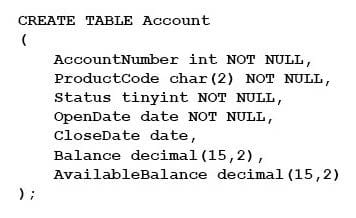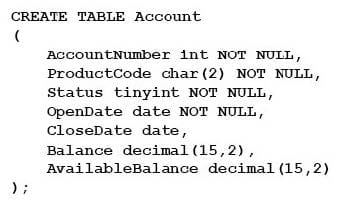70-762 Online Practice Questions and Answers
Note: this question is part of a series of questions that use the same or similar answer choices. An answer choice may be correct for more than one question in the series. Each question is independent of the other questions in the series.
Information and details provided in a question apply only to that question.
You are developing an application to track customer sales.
You need to create a database object that meets the following requirements:
-
Return a value of 0 if data inserted successfully into the Customers table.
-
Return a value of 1 if data is not inserted successfully into the Customers table.
-Support logic that is written by using managed code.
What should you create?
A. extended procedure
B. CLR procedure
C. user-defined procedure
D. DML trigger
E. DDL trigger
F. scalar-valued function G. table-valued function
Note: This question is part of a series of questions that present the same scenario. Each question in this series contains a unique solution. Determine whether the solution meets the stated goals. The Account table was created using the following Transact-SQL statement:

There are more than 1 billion records in the Account table. The Account Number column uniquely identifies each account. The ProductCode column has 100 different values. The values are evenly distributed in the table. Table statistics are refreshed and up to date.
You frequently run the following Transact-SQL SELECT statements:

You must avoid table scans when you run the queries. You need to create one or more indexes for the table. Solution: You run the following Transact-SQL statement:
CREATE CLUSTERED INDEX PK_Account ON Account(ProductCode);
Does the solution meet the goal?
A. Yes
B. No
Note: This question is part of a series of questions that present the same scenario. Each question in this series contains a unique solution. Determine whether the solution meets the stated goals. The Account table was created by using the following Transact-SQL statement:

There are more than 1 billion records in the Account table. The Account Number column uniquely identifies each account. The ProductCode column has 100 different values. The values are evenly distributed in the table. Table statistics are refreshed and up to date.
You frequently run the following Transact-SQL SELECT statements:

You must avoid table scans when you run the queries.
You need to create one or more indexes for the table.
Solution: You run the following Transact-SQL statement:
CREATE NONCLUSTERED INDEX IX_Account_ProductCode ON Account(ProductCode);
Does the solution meet the goal?
A. Yes
B. No
You are experiencing performance issues with the database server.
You need to evaluate schema locking issues, plan cache memory pressure points, and backup I/O problems.
What should you create?
A. a System Monitor report
B. a sys.dm_tran_database_transaction dynamic management view query
C. an Extended Events session that uses Query Editor
D. an Activity Monitor session in Microsoft SQL Management Studio.
Note: This question is part of a series of questions that present the same scenario. Each question in the series contains a unique solution that might meet the stated goals. Some questions sets might have more than one correct solution,
while others might not have a correct solution.
After you answer a question in this section, you will NOT be able to return to it. As a result, these questions will not appear in the review screen.
You have a 3-TB database. The database server has 64 CPU cores.
You plan to migrate the database to Microsoft Azure SQL Database.
You need to select the service tier for the Azure SQL database. The solution must meet or exceed the current processing capacity.
Solution: You select the Premium service tier.
Does this meet the goal?
A. Yes
B. No
You have the following stored procedure that is called by other stored procedures and applications:

You need to modify the stored procedure to meet the following requirements:
Always return a value to the caller.
Return 0 if @Status is NULL.
Callers must be able to use @Status as a variable.
Which two actions should you perform? Each correct answer presents part of the solution.
NOTE: Each correct selection is worth one point.
A. Replace NULL values with 0. Add a PRINT statement to return @Status.
B. Add a RETURN statement.
C. Replace NULL values with 0. Add an output parameter to return @Status.
D. Replace NULL values with 0. Add a SELECT statement to return @Status.
E. Add a PRINT statement.
F. Add a SELECT statement to return @Status.
G. Add an output parameter to return @Status.
You are creating the following two stored procedures: A natively-compiled stored procedure An interpreted stored procedure that accesses both disk-based and memory-optimized tables
Both stored procedures run within transactions.
You need to ensure that cross-container transactions are possible.
Which setting or option should you use?
A. the SET TRANSACTION_READ_COMMITTED isolation level for the connection
B. the SERIALIZABLE table hint on disk-based tables
C. the SET MEMORY_OPTIMIZED_ELEVATE_TO_SNAPSHOT=ON option for the database
D. the SET MEMORY_OPTIMIZED_ELEVATE_TO_SNAPSHOT=OFF option for the database
Note: this question is part of a series of questions that use the same or similar answer choices. An answer choice may be correct for more than one question in the series. Each question is independent of the other questions in the series.
Information and details provided in a question apply only to that question.
You are developing an application to track customer sales.
You need to create a database object that meets the following requirements:
Launch when table data is modified.
Evaluate the state a table before and after a data modification and take action based on the difference.
Prevent malicious or incorrect table data operations.
Prevent changes that violate referential integrity by cancelling the attempted data modification.
Run managed code packaged in an assembly that is created in the Microsoft.NET Framework and located into Microsoft SQL Server.
What should you create?
A. extended procedure
B. CLR procedure
C. user-defined procedure
D. DDL trigger
E. scalar-valued function
F. table-valued function
You manage a database that supports an Internet of Things (IoS) solution. The database records metrics from over 100 million devices every minute. The database requires 99.995% uptime.
The database uses a table named Checkins that is 100 gigabytes (GB) in size. The Checkins table stores metrics from the devices. The database also has a table named Archive that stores four terabytes (TB) of data. You use stored
procedures for all access to the tables.
You observe that the wait type PAGELATCH_IO causes large amounts of blocking.
You need to resolve the blocking issues while minimizing downtime for the database.
Which two actions should you perform? Each correct answer presents part of the solution.
A. Convert all stored procedures that access the Checkins table to natively compiled procedures.
B. Convert the Checkins table to an In-Memory OLTP table.
C. Convert all tables to clustered columnstore indexes.
D. Convert the Checkins table to a clustered columnstore index.
Note: This question is part of a series of questions that use the same or similar answer choices. An Answer choice may be correct for more than one question in the series. Each question independent of the other questions in this series.
Information and details provided in a question apply only to that question.
You are a database developer for a company. The company has a server that has multiple physical disks. The disks are not part of a RAID array. The server hosts three Microsoft SQL Server instances. There are many SQL jobs that run
during off-peak hours.
You must monitor and optimize the SQL Server to maximize throughput, response time, and overall SQL performance.
You need to examine delays in executed threads, including errors with queries and batches.
What should you do?
A. Create a sys.dm_os_waiting_tasks query.
B. Create a sys.dm_exec_sessions query.
C. Create a Performance Monitor Data Collector Set.
D. Create a sys.dm_os_memory_objects query.
E. Create a sp_configure `max server memory'query.
F. Create a SQL Profiler trace.
G. Create a sys.dm_os_wait_stats query.
H. Create an Extended Event.
You have multiple queries that take a long time to complete.
You need to identify the cause by using detailed information about the Transact-SQL statements in the queries. The Transact-SQL statements must not run as part of the analysis.
Which Transact-SQL statement should you run?
A. SET STATISTICS IO ON
B. SET SHOWPLAN_TEXT ON
C. SET STATISTICS XML ON
D. SET STATISTICS PROFILE ON
Note: This question is part of a series of questions that present the same scenario. Each question in the series contains a unique solution. Determine whether the solution meets the stated goals.
You need to identify the indexes that are not being used so that you can remove them from the database.
Solution: You run the sys.dm_db_index_physical_stats dynamic management view.
Does the solution meet the goal?
A. Yes
B. No
After you answer a question in this section, you will NOT be able to return to it. As a result, these questions will not appear in the review screen.
You need to collect data from the following two sources:
1.
The performance counters of the operating system
2.
Microsoft SQL Server events
You must analyze the two datasets side-by side by using a single tool.
Solution: You use dynamic management views and Data Collector Sets (DCs) in Performance Monitor to collect performance data. You use SQL Server Management Studio (SSMS) to analyze the data.
Does this meet the goal?
A. Yes
B. No
Note: This question is part of a series of questions that present the same scenario. Each question in the series contains a unique solution that might meet the stated goals. Some questions sets might have more than onecorrect solution, while others might not have a correct solution.
After you answer a question in this section, you will NOT be able to return to it. As a result, these questions will not appear in the review screen.
You need to collect data from the following two sources:
1.
The performance counters of the operating system
2.
Microsoft SQL Server events
You must analyze the two datasets side-by side by using a single tool.
Solution: You use dynamic management views and SQL Server Profiler to collect performance data. You use SQL Server Management Studio (SSMS) to analyze the data.
Does this meet the goal?
A. Yes
B. No
NOTE: This question is part of a series of questions that present the same scenario. Each question in the series contains a unique solution. Determine whether the solution meets the stated goals.
Your company has employees in different regions around the world.
You need to create a database table that stores the following employee attendance information:
1.
Employee ID
2.
Date and time employee checked in to work
3.
Date and time employee checked out of work
Date and time information must be time zone aware and must not store fractional seconds.
Solution: You run the following Transact-SQL statement:

Does the solution meet the goal?
A. Yes
B. No

